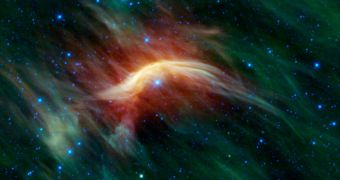A team of astronomers using a NASA telescope was recently able to see a very interesting bow shock in space, produced by a runaway star that was most likely ejected from a binary system. The celestial fireball is traveling at great speeds through cosmic dust, creating the astounding effect.
According to the latest measurements, the star is really massive, tipping the scale at an estimated 20 solar masses. It is currently pushing very fast through clouds of cosmic dust, which is why the yellowish bow shock is visible in the attached image.
The view was captured by the NASA Wide-field Infrared Survey Explorer (WISE) telescope, which surveys the sky in four IR wavelength rangers. The target of the new investigation is the massive star known as Zeta Ophiuchi.
For all its massive size, the star is dwarfed by the size of the bow shock it generates through the dust. It is represented by the blue dot at the center of the image. The original images were taken in infrared, but were colored so that we could see them in visible wavelengths.
Astronomers say that the object is currently traveling at an approximate speed of about 54,000 miles per hour (or 24 kilometers per second), heading towards the upper-left side of the image.
The reason why it's traveling so fast is that it was ejected from a binary star system, in which it spun around an even more massive celestial fireball. Zeta Ophiuchi was ejected when its companion blew up in a supernova.
After millions of years of being kept in orbit by huge gravitational forces – that were gone in a moment – the massive star shot away from the former binary system at great speed.
It creates the bow shock because it has entered a region that contains a lot of dust. The effect is similar to the one produced by a boat traveling on water, where it pushes a wave ahead. The larger the speed, the larger the wave.
The reason this stellar bow shock is visible is because the material making it up is highly compressed. This heats the otherwise-cold gas up, allowing WISE to pick up its existence.
Such cosmic structures are entirely invisible in optical wavelengths, which is precisely what makes infrared telescopes such as WISE so important, experts at the NASA Jet Propulsion Laboratory (JPL) explains.
The JPL manages the WISE mission for the NASA Science Mission Directorate, in Washington, DC, and is in turn managed by the California Institute of Technology (Caltech), in Pasadena.

 14 DAY TRIAL //
14 DAY TRIAL //